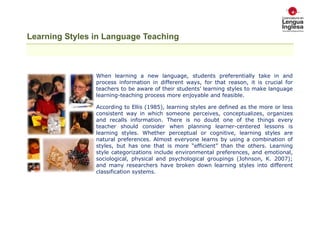
Learning styles in language teaching
- 1. Learning Styles in Language Teaching When learning a new language, students preferentially take in and process information in different ways, for that reason, it is crucial for teachers to be aware of their students’ learning styles to make language learning-teaching process more enjoyable and feasible. According to Ellis (1985), learning styles are defined as the more or less consistent way in which someone perceives, conceptualizes, organizes and recalls information. There is no doubt one of the things every teacher should consider when planning learner-centered lessons is learning styles. Whether perceptual or cognitive, learning styles are natural preferences. Almost everyone learns by using a combination of styles, but has one that is more “efficient” than the others. Learning style categorizations include environmental preferences, and emotional, sociological, physical and psychological groupings (Johnson, K. 2007); and many researchers have broken down learning styles into different classification systems.
- 2. Why should Teachers become aware of Learning Styles? One of the key aspects to keep in mind in language teaching is that teachers must become aware of their own styles. As Johnson (2007) states, teachers’ strongest learning style is probably their strongest teaching style. This is great for the students who have the same learning style as the teacher, but students with other strongest learning styles are often left out. Therefore, teachers must consciously work on including a wide range of activities and teaching materials in EFL lessons in order to encourage other ways of learning and help students learn more efficiently according to their personal styles. Beginning teachers will probably benefit most from the basics principles of the approach that incorporates Visual (seeing), Auditory (hearing), Kinesthetic (moving) and Tactile (touching) ways of learning. As coping with young language learners, it would be advisable to focus attention on students' classroom attitudes and behaviors which may prove somehow their dominant learning style. Being aware of common features can make learners' style be distinguished more easily by the teacher. EFL: English as a Foreign Language
- 3. Visual Learning Style VISUAL LEARNERS These learners need to see the teacher's body language and facial expression to fully understand the content of the lesson. They think in pictures and will be able to recall what they see and will prefer written instructions. Visual learners are sight readers who enjoy reading silently. They will learn best by observing and enjoy working with visual displays including diagrams, illustrations, transparencies, videos and hand-outs. FEATURES OF A VISUAL LEARNER: Enjoys looking at books Creates an orderly environment with work materials. Enjoys puzzles, board games, video segments. Notices details of surroundings. Watches the teacher's face. Understands directions right away if shown rather than told. Reproduces information by visualizing the text page. Usually works very quickly in class and finishes early. Rarely speaks in class or speaks in few words.
- 4. Auditory Learning Style AUDITORY LEARNERS These learners learn best through verbal lectures, discussions, talking things through and listening to what others have to say. Written information may have little meaning until it is heard. They often benefit from reading a text aloud and using a tape recorder. Students with this style will be able to recall what they hear and will prefer oral instructions. They learn by listening and speaking. These students enjoy talking and interviewing. They are phonetic readers who enjoy oral reading, choral reading, and listening to recorded books. FEATURES OF AN AUDITORY LEARNER: Usually the class clown. Is always chattering, whispering. Tells jokes and stories. Has many creative excuses. Uses rhythm and sound as memory aid. Can memorize easily. Can retell a story or message with high accuracy after one repetition. Seems brighter than test results (usually does poorly on written). Makes good group leade; does well in acting.
- 5. Kinesthetic/Tactile Learning Style KINESTHETIC & TACTILE LEARNERS Kinesthetic/Tactile people learn best through and hands-on approach, actively exploring the physical world around them. They may find it hard to sit still for long periods and may become distracted by their need for activity and exploration. These learners express themselves through movement. They have a good sense of balance and eye-hand coordination. They have to do things on their own to be able to learn the new language. Kinesthetic/Tactile learners learn best by touching or manipulating objects. They understand directions that they write and need to involve their whole body in learning. Total Physical Response is a good ESL method for them. They remember material best if they act it out. FEATURES OF A KINESTHETIC/TACTILE LEARNER: Must move, cannot sit down for normal periods of time. Doodles, folds papers, writes words over and over. Likes to do things with hands. Is good at taking things apart and putting them back together. Is good at sports and physical tasks. Uses movement and rhythmic routines as learning aids. Needs manipulative tasks to conceptualize abstract ideas. Learns best with quiet periods followed by active periods. Needs body space, should not be too close to other students.
- 6. Main Sources Workshop by Kitty Johnson, Regional English Language Officer, U.S. Embassy Held at University of Nariño in 2007. Ellis, R. 1985. Understanding Second Language Acquisition. Oxford: Oxford University Press.